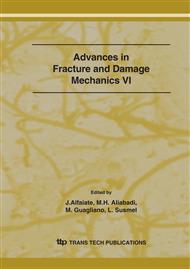p.609
p.613
p.617
p.621
p.625
p.629
p.633
p.637
p.641
Numerical Analysis of the Crack Growth in a High Loaded Bolt Connection
Abstract:
The present paper deals with the research on the crack growth in a bolt connection of a lug for crane counter weight bars. Counter weight bars are structural elements that are subjected to very heavy loads and therefore special attention must be paid. The main purpose of this research is to determine the number of the load cycles required for a crack to propagate from initial to critical crack length, when the final failure can be expected to occur. All required material parameters and the experimental results were determined in our previous research. The influence of the initial crack size upon the remaining life of the lug is researched numerically by means of finite element analysis and analytically by use of the corrected analytical model.
Info:
Periodical:
Pages:
625-628
Citation:
Online since:
September 2007
Authors:
Price:
Сopyright:
© 2007 Trans Tech Publications Ltd. All Rights Reserved
Share:
Citation:


